Friday 5 July 2019
Monday 1 July 2019
Three artists
Jae Maries
Jae Maries trained as a painter, doing a degree in Fine Art at Reading University before enrolling on a Post Graduate Diploma at Bright Polytechnic. She uses a sketchbook to record daily life using abstracted marks, which she later translates into larger artworks. Using simple shapes and colours, she makes her designs first in paper collage, then uses applique and hand and machine embroidery to interpret her theme. Her work, however, is unplanned and evolves through the various processes which she employs.
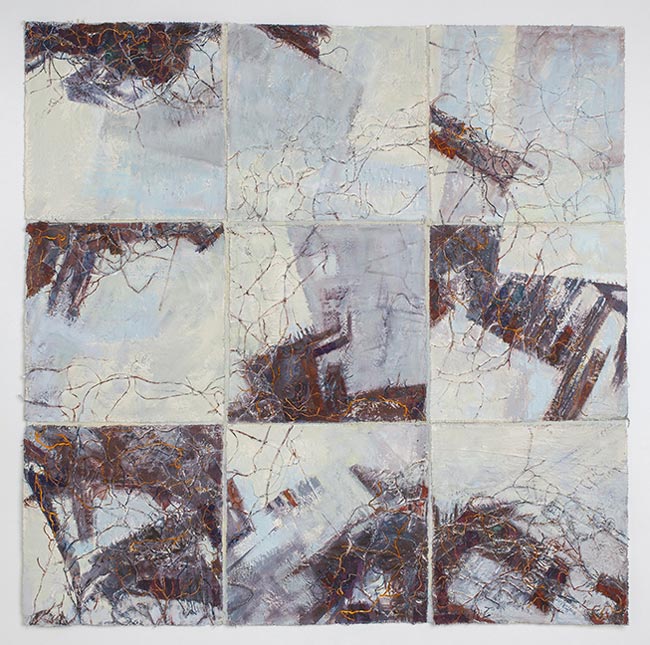
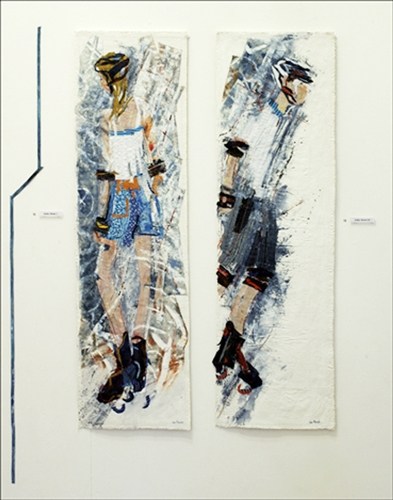
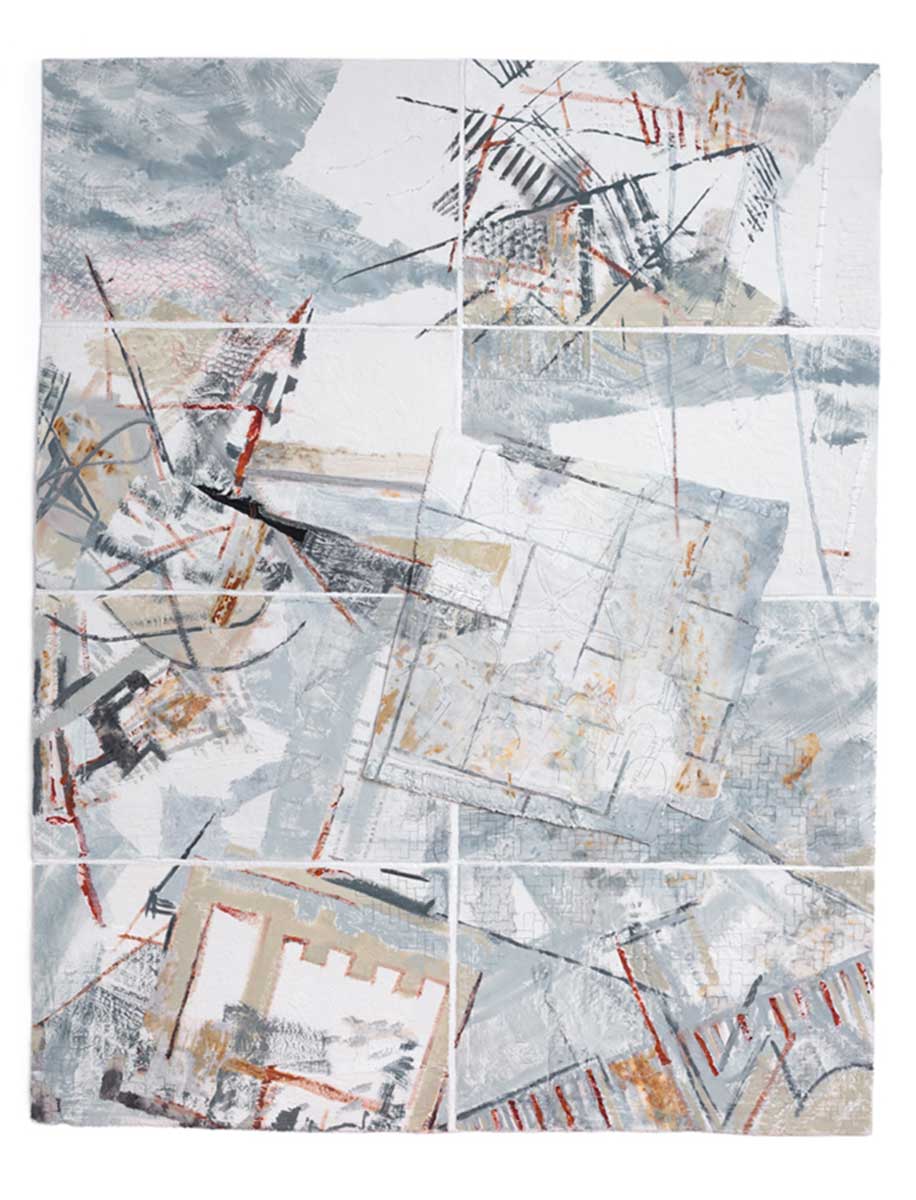 Her work 'Turbulent Seas' particularly relates to this module as it tells the story of an English fishing port, describing the decline of the fishing industry.
Her work 'Turbulent Seas' particularly relates to this module as it tells the story of an English fishing port, describing the decline of the fishing industry.
(62group.org.uk)
Barbara Lee Smith
Barbara Lee Smith is an American mixed media artist who creates large scale works of impressionistic landscapes and abstracts, always based closely on the environment, and celebrating nature. Born in New Jersey in 1938, she studied home economics at University, then married and moved to New York. Only at the age of 40 did she complete a Masters degree in Fine Art and begin to think of herself as a professional artist.

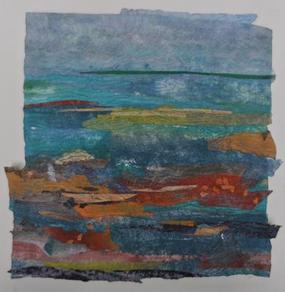

She was particularly impressed by the work of Jackson Pollock and Kandinsky and returned to college in the 1970's to study mixed media. Since graduating she has worked as a studio artist, first spraying dyes onto cotton or silk fabrics, then adding texture with multiple layers of fabric and machine stitch - always stitching from the back of the work so she can use rayon thread in the bobbin.
She describes her work as a three stage process of painting, collage and drawing.
Her relevance to this module results from Barbara's belief that creation arises from destruction and sees this in the environment as well as her work - 'the tide hauling detritus out to sea, transforming it and sending it back to the land'. She sees beauty in the midst of the mess, which is what we are attempting to achieve in this module, making an attractive piece of work which represents the devastation of environmental pollution.
(www.barbaraleesmith.com and textileartist.org)
Sandra Meech
Originally from Canada and now living in Somerset, Sandra Meech is a quilt artist who uses photo imagery, drawing and collage as a starting point for her work. Sandra trained as a fine artist and illustrator and was working as a graphic designer and art director in magazine publishing when she moved to London. A member of a number of textile groups including Studio 21, South West Textile Group and the international Quilt Art, she now exhibits widely and teaches in addition to having produced a whole series of books on creativity and design as well as art quilting.
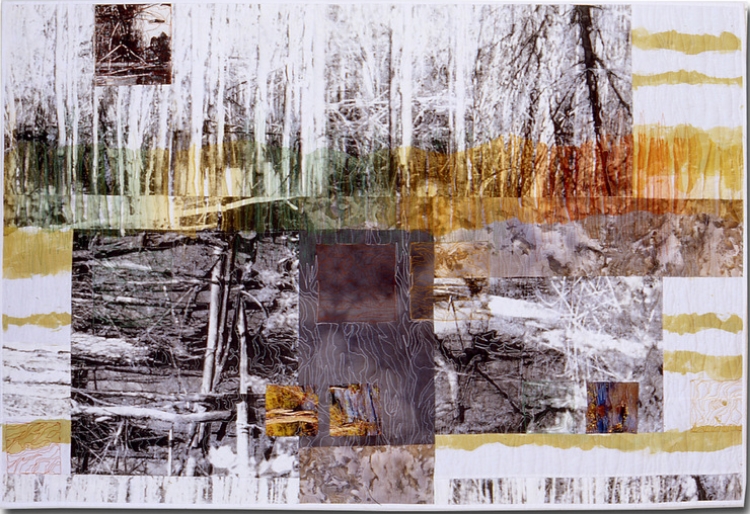 'Near North'
'Near North'
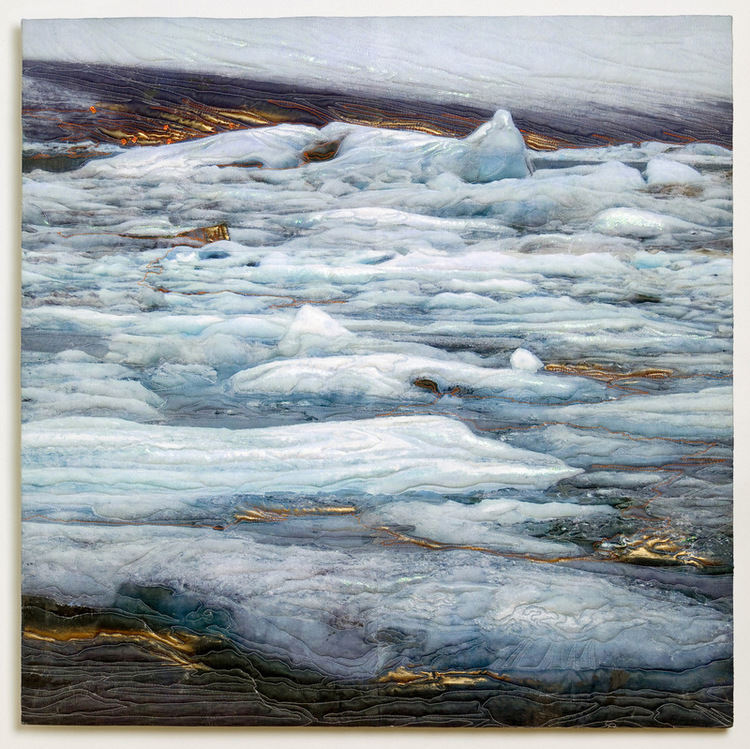
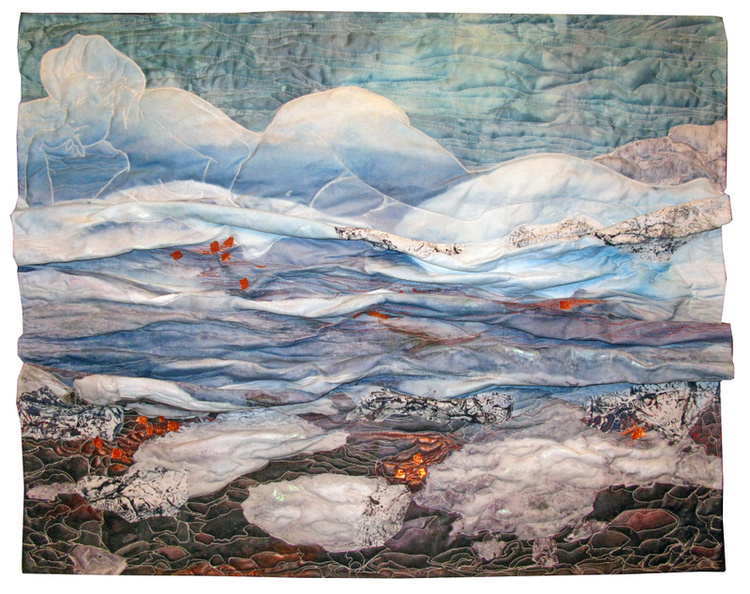 'What Were You Thinking?'
'What Were You Thinking?'
Inspired by nature, her works entitled 'Near North', which highlights the threats faced by woodland of climate change and urban sprawl, and 'Meltdown' in particular resonate with this module. Meltdown is a series of textile pieces highlighting the melting ice in Arctic Canada, the final piece in the series being entitled 'What Were You Thinking?' shows Mother Nature looking down at the melting ice.
(www.arttextilesmadeinbritain.co.uk; www.sandrameech.com; studio21textileart.co.uk)
Jae Maries trained as a painter, doing a degree in Fine Art at Reading University before enrolling on a Post Graduate Diploma at Bright Polytechnic. She uses a sketchbook to record daily life using abstracted marks, which she later translates into larger artworks. Using simple shapes and colours, she makes her designs first in paper collage, then uses applique and hand and machine embroidery to interpret her theme. Her work, however, is unplanned and evolves through the various processes which she employs.

Deep Freeze

Roller Bladers
Jae is a member of the 62 Group of Textile Artists and draws inspiration for her work from figures in the environment and from her travels around the world. She has commissioned pieces hanging in a number of public places, is a freelance lecturer and tutor, exhibits internationally and has written a book entitled 'Contrasting Elements'

(62group.org.uk)
Barbara Lee Smith
Barbara Lee Smith is an American mixed media artist who creates large scale works of impressionistic landscapes and abstracts, always based closely on the environment, and celebrating nature. Born in New Jersey in 1938, she studied home economics at University, then married and moved to New York. Only at the age of 40 did she complete a Masters degree in Fine Art and begin to think of herself as a professional artist.



She was particularly impressed by the work of Jackson Pollock and Kandinsky and returned to college in the 1970's to study mixed media. Since graduating she has worked as a studio artist, first spraying dyes onto cotton or silk fabrics, then adding texture with multiple layers of fabric and machine stitch - always stitching from the back of the work so she can use rayon thread in the bobbin.
She describes her work as a three stage process of painting, collage and drawing.
Her relevance to this module results from Barbara's belief that creation arises from destruction and sees this in the environment as well as her work - 'the tide hauling detritus out to sea, transforming it and sending it back to the land'. She sees beauty in the midst of the mess, which is what we are attempting to achieve in this module, making an attractive piece of work which represents the devastation of environmental pollution.
(www.barbaraleesmith.com and textileartist.org)
Sandra Meech
Originally from Canada and now living in Somerset, Sandra Meech is a quilt artist who uses photo imagery, drawing and collage as a starting point for her work. Sandra trained as a fine artist and illustrator and was working as a graphic designer and art director in magazine publishing when she moved to London. A member of a number of textile groups including Studio 21, South West Textile Group and the international Quilt Art, she now exhibits widely and teaches in addition to having produced a whole series of books on creativity and design as well as art quilting.
 'Near North'
'Near North' 
'Meltdown'
 'What Were You Thinking?'
'What Were You Thinking?'(www.arttextilesmadeinbritain.co.uk; www.sandrameech.com; studio21textileart.co.uk)
Final wallhanging
My final piece for this course (Fig. 1 & 2) was certainly both a challenge and, being large, abstract and machine embroidered, so far outside my comfort zone, that I have found it difficult to judge its worth. It meets the brief in that it is a little larger than A1 size and is based on the topic of conservation.
Inspired by the twin threats to the Yorkshire region where I live of moorland fires and regular flooding I believe that the work represents these phenomena effectively. My personal preferred stitching method is needlelace and I wanted this piece to also be lacy as it was important to me that it had at least some bearing or link to my 'normal' style. I achieved this by making each piece of machine embroidery from scrim, which was slashed before stitching and then backed with a different colour of scrim to represent the movement in both the flames and the flood water (Fig. 6 is an example of the method used). The whole wallhanging is mounted on a pale grey net tulle which adds to the lacy effect.
Some strips of stitching were made wider and longer than their allotted space, which allowed me to use the furrowing technique learned in the previous module, to attach them to the backing (Fig. 3 & 4 are examples). The black square (Fig. 8) represents the homes which are under threat and the fear and continuing anxiety of their occupants. To add to this imagery I backed the black scrim with red, used a spiralling stitch to represent the smoke damage and added a border of machine stitched lace to reference the doileys that may be in the homes.
This same spiralling stitching is echoed on some of the strips (Fig. 7) to represent the smoke in the air, which often means that people in the vicinity must keep windows and doors closed to avoid smoke inhalation.
I made three A3 size design boards which are hinged together with the board shown in Fig. 10 in the centre.
The wallhanging has taken a long time to make, partly because I unpicked it from the net backing at least twice because I was unhappy with the way it looked. I stitched a channel in the top edge of the net backing, which allows it to hang from an expanding curtain rail at my cloakroom window. On the whole I am happy with how the piece has turned out and I do like the way the light shining through it from the window, again adds to the ethereal and lacy effect.
If I were to make it again I would certainly trust my own instincts more and not be swayed by friends' comments or 'advice' (and would then probably have to do a lot less unpicking!). I might also try backing it with a different fabric - maybe an organza - as I had intended to machine stitch the backing but the net stretched and gathered, making this impossible.
The course as a whole:
A textile related qualification has been a long held dream but career and family commitments have always prevented me from going down that path. I woke up on new year's morning four years ago and decided that if I didn't follow that dream now then I never would. The course has taken longer than I initially intended but then again when I began I had no idea that in addition to that qualification I would also have two beautiful grandsons by the time I had finished.
Two main things influenced my choice of course:
1. It could be done entirely by distance learning. I don't drive and travel to some of the alternatives on offer at the time would at best have been difficult by public transport.
2. Having read the course description and looked through the student galleries online I knew the course would challenge me and take me out of my comfort zone... important to keep the little grey cells firing on all cylinders!!
This has certainly been the case and I have learned a great deal in the process, I have learned:-
Costing
Sketchbook: £4.99
Fabric: most was taken from stock bought for earlier modules - estimate approximately £5.
Soluble fabric for the whole module: £12.50 though there is lots left for future use.
Dyes for scrim for final wallhanging: £3
Storage of materials and health and safety:
See earlier modules for details of this. Specific areas of health and safety for this module are as follows:
Dyeing fabrics
Take care when mixing dyes, wearing a dust mask and gloves in a well ventilated area to avoid inhalation. Keep powders and any mixed dyes and solutions stored securely, clearly labelled and away from children and pets.
Machine stitching
Your chair should have a firm backrest and allow your feet to rest flat on the floor and at a height that is comfortable and your machine should sit on a firm table and be in good natural light. Keep fingers well away from the needle whilst stitching - an embroidery hoop facilitates this.
Inspired by the twin threats to the Yorkshire region where I live of moorland fires and regular flooding I believe that the work represents these phenomena effectively. My personal preferred stitching method is needlelace and I wanted this piece to also be lacy as it was important to me that it had at least some bearing or link to my 'normal' style. I achieved this by making each piece of machine embroidery from scrim, which was slashed before stitching and then backed with a different colour of scrim to represent the movement in both the flames and the flood water (Fig. 6 is an example of the method used). The whole wallhanging is mounted on a pale grey net tulle which adds to the lacy effect.
Fig. 1
Fig. 2
Fig. 3
Fig. 4
Fig. 5
Fig. 6
Fig. 7
Fig. 8
Fig. 9 - Fire
Fig. 10 - Original design
Fig. 11 - Flood
Some strips of stitching were made wider and longer than their allotted space, which allowed me to use the furrowing technique learned in the previous module, to attach them to the backing (Fig. 3 & 4 are examples). The black square (Fig. 8) represents the homes which are under threat and the fear and continuing anxiety of their occupants. To add to this imagery I backed the black scrim with red, used a spiralling stitch to represent the smoke damage and added a border of machine stitched lace to reference the doileys that may be in the homes.
This same spiralling stitching is echoed on some of the strips (Fig. 7) to represent the smoke in the air, which often means that people in the vicinity must keep windows and doors closed to avoid smoke inhalation.
I made three A3 size design boards which are hinged together with the board shown in Fig. 10 in the centre.
The wallhanging has taken a long time to make, partly because I unpicked it from the net backing at least twice because I was unhappy with the way it looked. I stitched a channel in the top edge of the net backing, which allows it to hang from an expanding curtain rail at my cloakroom window. On the whole I am happy with how the piece has turned out and I do like the way the light shining through it from the window, again adds to the ethereal and lacy effect.
If I were to make it again I would certainly trust my own instincts more and not be swayed by friends' comments or 'advice' (and would then probably have to do a lot less unpicking!). I might also try backing it with a different fabric - maybe an organza - as I had intended to machine stitch the backing but the net stretched and gathered, making this impossible.
The course as a whole:
A textile related qualification has been a long held dream but career and family commitments have always prevented me from going down that path. I woke up on new year's morning four years ago and decided that if I didn't follow that dream now then I never would. The course has taken longer than I initially intended but then again when I began I had no idea that in addition to that qualification I would also have two beautiful grandsons by the time I had finished.
Two main things influenced my choice of course:
1. It could be done entirely by distance learning. I don't drive and travel to some of the alternatives on offer at the time would at best have been difficult by public transport.
2. Having read the course description and looked through the student galleries online I knew the course would challenge me and take me out of my comfort zone... important to keep the little grey cells firing on all cylinders!!
This has certainly been the case and I have learned a great deal in the process, I have learned:-
- to make better use of a workbook;
- new ways of designing a piece of work;
- to design first in paper - cheaper than experimenting immediately with sometimes expensive fabric and thread;
- it is not necessary to stick slavishly to that paper design;
- to work in a more free way;
- to enjoy machine embroidery (a major revelation);
- to work in a more abstract way
Costing
Sketchbook: £4.99
Fabric: most was taken from stock bought for earlier modules - estimate approximately £5.
Soluble fabric for the whole module: £12.50 though there is lots left for future use.
Dyes for scrim for final wallhanging: £3
Storage of materials and health and safety:
See earlier modules for details of this. Specific areas of health and safety for this module are as follows:
Dyeing fabrics
Take care when mixing dyes, wearing a dust mask and gloves in a well ventilated area to avoid inhalation. Keep powders and any mixed dyes and solutions stored securely, clearly labelled and away from children and pets.
Machine stitching
Your chair should have a firm backrest and allow your feet to rest flat on the floor and at a height that is comfortable and your machine should sit on a firm table and be in good natural light. Keep fingers well away from the needle whilst stitching - an embroidery hoop facilitates this.
Subscribe to:
Posts (Atom)











